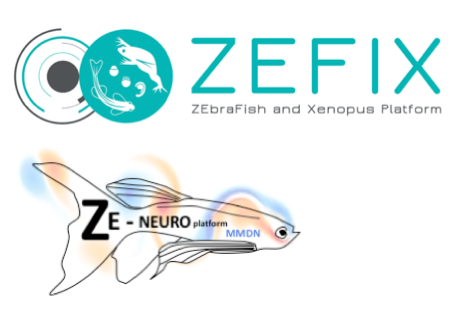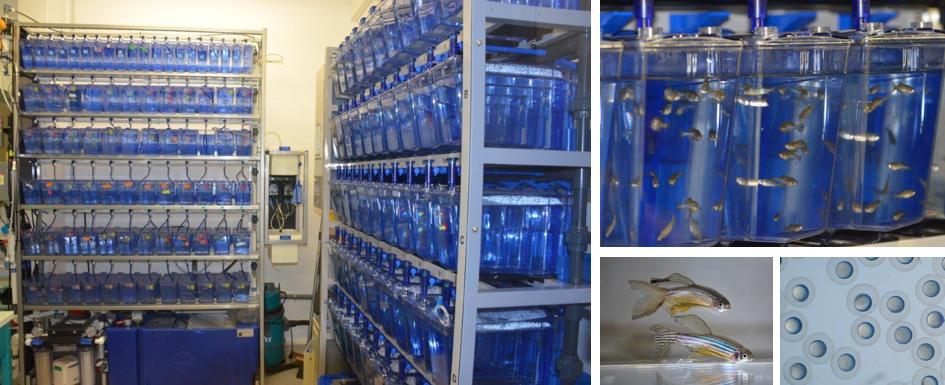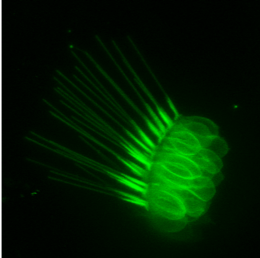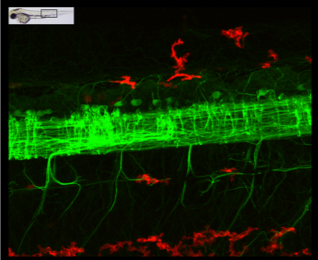ZEneuro Zebrafish platform
About

The ZeNeuro zebrafish platform within the MMDN laboratory allows the development of new in vivo models in order to understand the processes of neuronal degeneration.
We have established an expertise in the development and analysis of the central and peripheral nervous system and we currently host about 30 transgenic and mutant lines.

We follow the first steps of the neurotoxicity visible from two days of development in zebrafish. Neuronal damage can thus be followed directly at the cell and organism level, including behavioral analysis with the ZebraSens phenotyping platform. Our models allow us to test candidate proteins or compounds for therapeutic purposes.
This platform, which is accessible to the scientific community, has enabled us to develop various projects in collaboration:
- Impact of pesticides and endocrine disruptors on the nervous system (V. Perrier, U1198)
- Study of candidate genes in ALS (INM, Montpellier)
- EStudy of candidate genes in optical neuropathies (INM, Montpellier)
On the other hand, this platform is involved in the functional validation of therapeutic agents in various fields:
- Nanoparticles (IBMM, Montpellier)
- Study of theranostic compounds (EPHE - University of Burgundy)
- Validation of neuroprotective molecules in the Wolfram syndrom (MMDN)
- Validation of neuroprotective molecules in SLA (MMDN)
We ensure the supervision of students (Master Bio-Health/Biotin M1, M2, Master EPHE), engineers, doctoral students, post-doctoral students and researchers et chercheur(e)s for microinjection techniques at different stages, for the manipulation of embryos and larvae for imaging. In addition, all users are trained in good practices for the use of the model (zootechnics, experimentation, regulations).
 |
 |
|
Cellules ciliées de l’oreille (cristae), lignée Brn3c-GFP, une atteinte de cette structure peut conduire à des défauts d’équilibre et d’audition |
Protéine Tau humaine exprimée dans le système nerveux (vert) en interaction avec la microglie (rouge) |
Group
Mireille Rossel, scientific leader
 |
Maître de conférences, EPHE Contact: mireille.rossel(at)umontpellier.fr / mireille.rossel(at)ephe.sorbonne.fr Téléphone : 04 67 14 38 15 |
Nicolas Cubedo, head of zootechnics and microinjection
 |
Assistant ingénieur Inserm Contact: nicolas.cubedo(at)umontpellier.fr Téléphone : 04 67 14 38 15 |
References
- Mezghrani B, Ali LMA, Cubedo N, Rossel M, Hesemann P, Durand JO, Bettache N. Periodic mesoporous ionosilica nanoparticles for dual cancer therapy: Two-photon excitation siRNA gene silencing in cells and photodynamic therapy in zebrafish embryos. Int J Pharm 2023, 641, 123083.
- Vaché C, Cubedo N, Mansard L, Sarniguet J, Baux D, Faugère V, Baudoin C, Moclyn M, Touraine R, Lina-Granade G, Cossé M, Bergougnoux A, Kalatzis V, Rossel M, Roux AF. Identification and in vivo functional investigation of a HOMER2 nonstop variant causing hearing loss. Eur J Hum Genet 2023, 31, 834-840.
- Crouzier L, Danese A, Yasui Y, Richard EM, Liévens JC, Patergnani S, Couly S, Diez C, Denus M, Cubedo N, Rossel M, Thiry M, Su TP, Pinton P, Maurice T, Delprat B. Activation of the sigma-1 receptor chaperone alleviates disorders of Wolfram syndrome by restoring ER-mitochondrion signaling. Science Transl Med 2022, 14, 631.
- Crouzier L, Richard EM, Diez C, Alzaeem H, Denus M, Cubedo N, Delaunay T, Glendenning E, Baxendale S, Liévens JC, Whitfield TT, Maurice T, Delprat B. Morphological, behavioral and cellular analyses revealed different phenotype in Wolfram syndrome wfs1a and wfs1b zebrafish mutant lines. Hum Mol Genet. 2022, 31, 2711-2727.
- Crouzier L, Richard EM, Diez C, Denus M, Peyrel A, Alzaeem H, Cubedo N, Delaunay T, Maurice T, Delprat B. NCS1 overexpression restored mitochondrial activity and behavioral alterations in a zebrafish model of Wolfram syndrome. Mol Therapy, 2022, 27, 295-308.
- Lasbleiz C, Peyrel A, Tarot P, Sarniguet J, Crouzier L, Cubedo N, Delprat B, Rossel M, Maurice T, Liévens JC. Sigma-1 receptor agonist PRE-084 confers protection against TAR DNA-binding protein-43 toxicity through NRF2 signalling. Redox Biol 2022, 58, 102542.
- Nasri A, Lafon PA, Mezni A, Clair P, Cubedo N, Mahmoudi E, Beyrem H, Rossel M, Perrier V. Developmental exposure to the A6-pesticide causes changes in tyrosine hydroxylase gene expression, neurochemistry, and locomotors behavior in larval zebrafish. Toxicol Mech Methods. 2022, 32, 569-579.
- Barbereau C, Cubedo N, Maurice T, Rossel M. Zebrafish models to study new pathways in tauopathies. Int J Mol Sci. 2021;22:4626.
- Bassani S, van Beelen E, Rossel M, Voisin N, Morgan A, Arribat Y, Chatron N, Chrast J, Cocca M, Delprat B, Faletra F, Giannuzzi G, Guex N, Machavoine R, Pradervand S, Smits JJ, van de Kamp JM, Ziegler A, Amati F, Marlin S, Kremer H, Locher H, Maurice T, Gasparini P, Girotto G, Reymond A. Variants in USP48 encoding ubiquitin hydrolase are associated with autosomal dominant non-syndromic hereditary hearing loss. Hum Mol Genet. 2021 Sep 15;30(19):1785-1796.
- Cahu M, Ali LMA, Sene S, Long J, Camerel F, Ciancone M, Salles F, Chopineau J, Devoisselle JM, Felix G, Cubedo N, Rossel M, Guari Y, Bettache N, Larionova J, Gary-Bobo M. A rational study of the influence of Mn2+-insertion in Prussian blue nanoparticles on their photothermal properties. J Mater Chem B. 2021 Dec 8;9(47):9670-9683.
- Crouzier L, Denus M, Richard EM, Tavernier A, Diez C, Cubedo N, Maurice T, Delprat B. Sigma-1 Receptor Is Critical for Mitochondrial Activity and Unfolded Protein Response in Larval Zebrafish. Int J Mol Sci. 2021 Oct 13;22(20):11049.
Figures
Cellules ciliées de l’oreille de larve de poisson-zèbre, marquées par la protéine fluorescente verte GFP. L’oreille est délimitée par les pointillés blancs et contient 3 groupes visibles de cellules ciliées, les cristas (encadrés blancs), dont les longs cils sont caractéristiques. Un agrandissement d’un des groupes montre la structure de ces cellules. Une atteinte de cette structure peut conduire à des défauts d’équilibre et d’audition.
